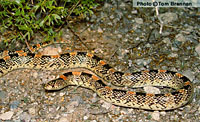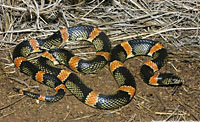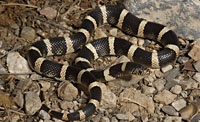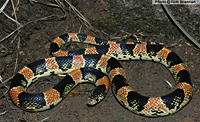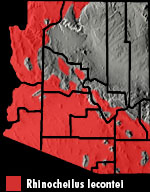Online Field Guide to The Reptiles and Amphibians of Arizona


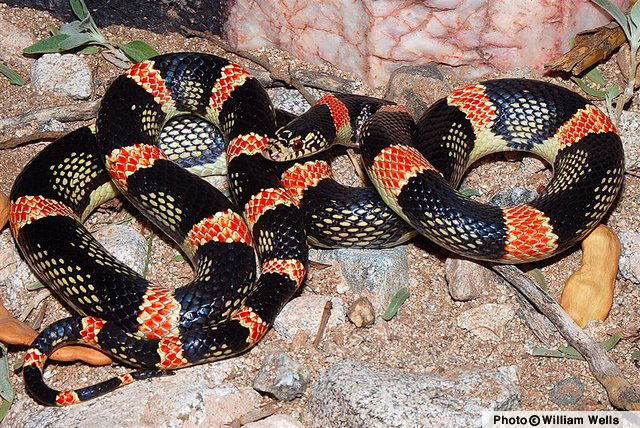
Arizona
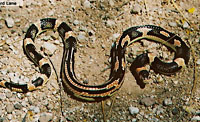 Aberrant (striped). Pima Co., AZ |
||
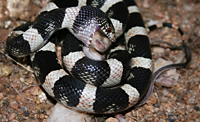 Eating mouse. Mohave Co., AZ |
| LONG-NOSED SNAKE Rhinocheilus lecontei |
Non-Venomous
|
|
DESCRIPTION: This snake can grow to 1,520 mm but in Arizona most individuals are less than 890 mm or 35″ in total length. The head is narrow, the lower jaw is countersunk, and, in profile, the snout is pointed. The scales are smooth and shiny, most of the subcaudal scales are undivided, the pupils are round, and the irises are red or orange. Body markings are highly variable but generally consist of black saddles surrounded by white, cream, or yellow interspaces with or without pinkish red suffusions. Most Arizona specimens fit into one of two pattern morphs: “clarus morph” or “lecontei morph”. DISTRIBUTION: This common and widespread snake is found across the flatlands and valleys of southern and western Arizona at elevations ranging from near sea level along the Colorado River to about 6,000′. It is also found on the plateaus of the Arizona Strip (land north of the Colorado River). HABITAT: In Arizona it is found primarily in sparsely vegetated desertscrub communities and Semidesert Grassland but it extends up into the lower reaches of the woodlands in some areas. It inhabits low desert ranges, foothills, valleys, and flatlands with sandy, gravelly, or moderately rocky soils. It is usually absent from steep mountainous terrain. DIET: The Long-nosed Snake is a constrictor that actively forages for lizards, small mammals, snake and lizard eggs, and occasionally grasshoppers. Whiptail lizards (Aspidoscelis) make up a large percentage of its diet. Small snakes feed almost exclusively on lizards. Larger individuals include small mammals in their diet. REPRODUCTION: Mating probably takes place primarily in April and May. Studies suggest that not all females breed each year. Egg laying takes place mainly in June and July, but August oviposition has been reported as well. Clutch size ranges from 3 to 11 eggs. Incubation periods range from 42 to 90 days and most eggs hatch in August or September. Bartlett. 2000. Snakes of North America: Western Brennan, T. C., and A. T. Holycross. 2006. A Field Guide to Amphibians and Reptiles in Arizona. Arizona Game and Fish Department. Phoenix, AZ Brennan, T. C., and A. T. Holycross. 2005. A Field Guide to Amphibians and Reptiles of Maricopa County. Arizona Game and Fish Department. Phoenix, AZ Fowlie. 1965. The Snakes of Arizona. Azul Quinta Press, Fallbrook, California Stebbins. 1985. Western Reptiles and Amphibians. Houghton Mifflin. New York, |
|
Visit Partners in Amphibian and Reptile Conservation:


HOME
Copyright © 2023, Arizona Game and Fish Department. All rights reserved.
If you make use of the textual contents of this site in reports, publications, etc. please cite and credit the author(s) and photographer(s). All photos on this website are copyrighted. However, those found in the species account section may be used for any noncommercial scientific, educational, or conservation purposes provided that photographs are not altered and continue to bear the copyright symbol and name of the photographer. Please contact the photographer regarding commercial use of copyrighted photographs.










